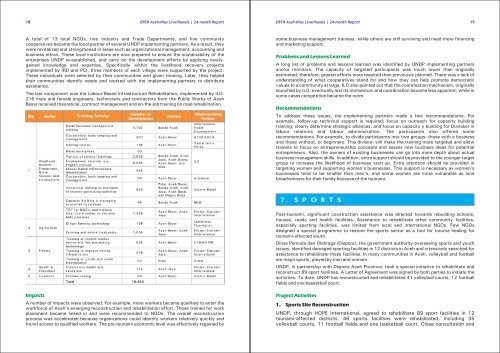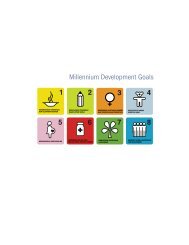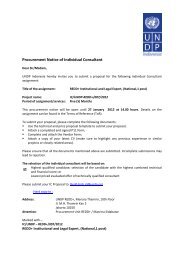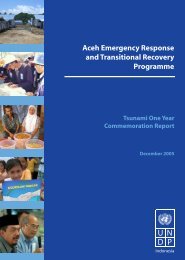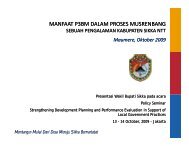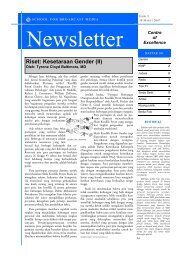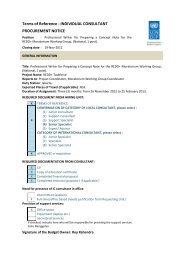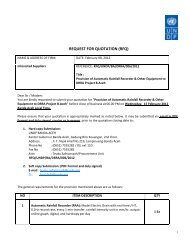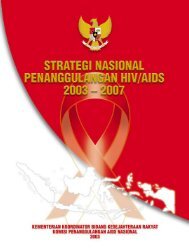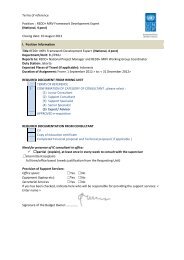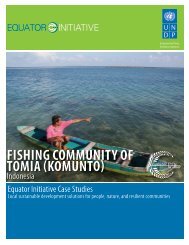(ERTR) Livelihoods Programme - UNDP
(ERTR) Livelihoods Programme - UNDP
(ERTR) Livelihoods Programme - UNDP
You also want an ePaper? Increase the reach of your titles
YUMPU automatically turns print PDFs into web optimized ePapers that Google loves.
18<br />
<strong>ERTR</strong> Aceh-Nias <strong>Livelihoods</strong> | 24-month Report<br />
<strong>ERTR</strong> Aceh-Nias <strong>Livelihoods</strong> | 24-month Report<br />
19<br />
A total of 13 local NGOs, two Industry and Trade Departments, and five community<br />
cooperatives became the local partner of several <strong>UNDP</strong> implementing partners. As a result, they<br />
were revitalized and strengthened in areas such as organizational management, accounting and<br />
business ethics. These local institutions are now prepared to ensure the sustainability of the<br />
enterprises <strong>UNDP</strong> re-established, and carry on the development efforts by applying newlygained<br />
knowledge and expertise. Specifically within the livelihood recovery projects<br />
implemented by IRD and PCI, three members of each village were supported by the project.<br />
These individuals were selected by their communities and given training. Later, they helped<br />
their communities identify needs and worked with the implementing partners to distribute<br />
assistance.<br />
The last component was the Labour-Based Infrastructure Rehabilitation, implemented by ILO.<br />
216 male and female engineers, technicians and contractors from the Public Works of Aceh<br />
Besar received theoretical, contract management and on-the-job training on road rehabilitation.<br />
No Sector Training Activity<br />
Number of<br />
Beneficiaries<br />
District<br />
Implementing<br />
Partner<br />
some business management trainees, while others are still surviving and need more financing<br />
and marketing support.<br />
Problems and Lessons Learned<br />
A long list of problems and lessons learned was identified by <strong>UNDP</strong> implementing partners<br />
and/or monitors. The capacity of targeted participants was much lower than originally<br />
estimated; therefore, greater efforts were required than previously planned. There was a lack of<br />
understanding of what cooperatives stand for and how they can help promote democratic<br />
values to a community at large. ILO also pointed out that the coordination mechanism, originally<br />
launched by ILO, eventually lost its momentum and coordination became less apparent, while in<br />
some cases competition became the norm.<br />
Recommendations<br />
To address these issues, the implementing partners made a few recommendations. For<br />
example, follow-up technical support is required; focus on outreach for capacity building<br />
training; clearly determine strategic alliances; and focus on capacity y building for Disnaker in<br />
labour relations and labour administration. The participants also offered some<br />
recommendations. For example, to divide participants into two groups: those with a business<br />
and those without, or beginners. This division will make the training more targeted and allow<br />
trainers to focus on entrepreneurship concepts and assess new business ideas for potential<br />
entrepreneurs. Also, the owners of existing businesses can go into more depth about actual<br />
business management skills. In addition, extra support should be provided to the younger target<br />
group to increase the likelihood of business start-up. Extra attention should be provided in<br />
targeting women and supporting women's businesses. This support is necessary as women's<br />
businesses tend to be smaller than men's, and some women are more vulnerable as lone<br />
breadwinners for their family because of the tsunami.<br />
7 . S P O R T S<br />
Post-tsunami, significant construction assistance was directed towards rebuilding schools,<br />
houses, roads and health facilities. Assistance to rehabilitate other community facilities,<br />
especially sporting facilities, was limited from local and international NGOs. Few NGOs<br />
designed a special programme to restore the sports sector as a tool for trauma healing for<br />
tsunami-affected youth.<br />
Dinas Pemuda dan Olahraga (Dispora), the government authority overseeing sports and youth<br />
issues, identified damaged sporting facilities in 12 districts in Aceh and intensively searched for<br />
assistance to rehabilitate these facilities. In many communities in Aceh, volleyball and football<br />
are major sports, played by men and women.<br />
<strong>UNDP</strong>, in partnership with Dispora Aceh Province, took a special initiative to rehabilitate and<br />
reconstruct 89 sport facilities. A Letter of Agreement was signed by both parties to initiate the<br />
activities. To date, <strong>UNDP</strong> has reconstructed and rehabilitated 41 volleyball courts, 12 football<br />
fields and one basketball court.<br />
Impacts<br />
A number of impacts were observed. For example, more workers became qualified to enter the<br />
workforce of Aceh's emerging reconstruction and rehabilitation effort. Those trained for work<br />
placement became linked in and were recommended to NGOs. The overall reconstruction<br />
process was accelerated because organizations could identify workers relatively quickly and<br />
found access to qualified workers. The pre-tsunami economic level was effectively regained by<br />
Project Activities<br />
1. Sports Site Reconstruction<br />
<strong>UNDP</strong>, through HOPE International, agreed to rehabilitate 89 sport facilities in 12<br />
tsunami-affected districts. 46 sports facilities were rehabilitated, including 35<br />
volleyball courts, 11 football fields and one basketball court. Close consultation and


